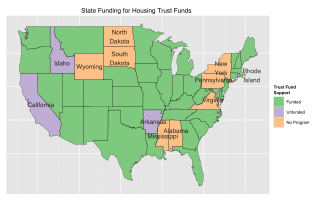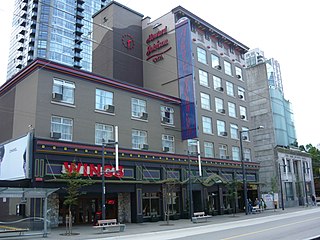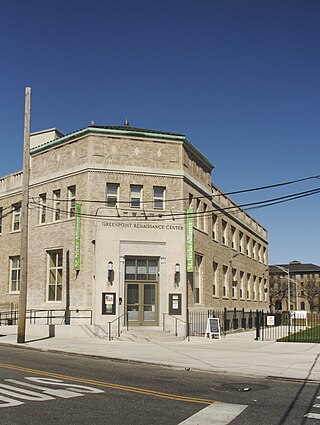
Homelessness in Canada was not a social problem until the 1980s. The Canadian government housing policies and programs in place throughout the 1970s were based on a concept of shelter as a basic need or requirement for survival and of the obligation of government and society to provide adequate housing for everyone. Public policies shifted away from rehousing in the 1980s in wealthy Western countries like Canada, which led to a de-housing of households that had previously been housed. By 1987, when the United Nations established the International Year of Shelter for the Homeless (IYSH), homelessness had become a serious social problem in Canada. The report of the major 1987 IYSH conference held in Ottawa said that housing was not a high priority for government, and this was a significant contributor to the homelessness problem. While there was a demand for adequate and affordable housing for low income Canadian families, government funding was not available. In the 1980s a "wider segment of the population" began to experience homelessness for the first time – evident through their use of emergency shelters and soup kitchens. Shelters began to experience overcrowding, and demand for services for the homeless was constantly increasing. A series of cuts were made to national housing programs by the federal government through the mid-1980s and in the 1990s. While Canada's economy was robust, the cuts continued and in some cases accelerated in the 1990s, including cuts to the 1973 national affordable housing program. The government solution for homelessness was to create more homeless shelters and to increase emergency services. In the larger metropolitan areas like Toronto the use of homeless shelters increased by 75% from 1988 to 1998. Urban centres such as Montreal, Laval, Vancouver, Edmonton, and Calgary all experienced increasing homelessness.

Canada Mortgage and Housing Corporation is Canada's federal crown corporation responsible for administering the National Housing Act, with the mandate to improve housing by living conditions in the country.
Supportive housing is a combination of housing and services intended as a cost-effective way to help people live more stable, productive lives, and is an active "community services and funding" stream across the United States. It was developed by different professional academics and US governmental departments that supported housing. Supportive housing is widely believed to work well for those who face the most complex challenges—individuals and families confronted with homelessness and who also have very low incomes and/or serious, persistent issues that may include substance use disorders, mental health, HIV/AIDS, chronic illness, diverse disabilities or other serious challenges to stable housing.

Affordable housing is housing which is deemed affordable to those with a household income at or below the median as rated by the national government or a local government by a recognized housing affordability index. Most of the literature on affordable housing refers to mortgages and a number of forms that exist along a continuum – from emergency homeless shelters, to transitional housing, to non-market rental, to formal and informal rental, indigenous housing, and ending with affordable home ownership.

The Alliance for Retired Americans (ARA) is a 501(c)(4) non-profit organization and nonpartisan organization of retired trade union members affiliated with the AFL-CIO, which founded it in 2001. The group's membership also includes non-union, community-based activists. Its predecessor organization was known as the National Council of Senior Citizens (NCSC).
The New York State Housing Finance Agency (HFA) is a New York State public-benefit corporation created in 1960 to increase the supply of rental housing for low-income people by issuing bonds and providing low-interest mortgage loans to regulated housing companies.

The Philippines' National Council on Disability Affairs (NCDA) is the national government agency mandated to formulate policies and coordinate the activities of all agencies, whether public or private, concerning disability issues and concerns. As such, the NCWDP is the lead agency tasked to steer the course of program development for persons with disabilities and the delivery of services to the sector.

Housing refers to the usage and possibly construction of shelter as living spaces, individually or collectively. Housing is a basic human need and a human right, playing a critical role in shaping the quality of life for individuals, families, and communities, As such it is the main issue of housing organization and policy.
National Network for Youth (NN4Y) was founded in 1974 as the National Network of Runaway and Youth Services (NNRYS), as a membership association of community-based organizations that aimed to focus on the needs of youth in runaway and homeless situations. Today, NN4Y represents more than 530 community-based organizations s in the United States and territories. NN4Y members work with their neighborhood youth, adults, associations, and regional and state networks of youth workers to provide street-based services, emergency shelter, transitional living programs, counseling, and social, health, educational and job-related services to over 2.5 million youth each year.
Public housing policies in Canada includes rent controls, as well as subsidized interest rates and grants. Early public housing policy in Canada consisted of public-private lending schemes which focused on expanding home ownership among the middle class. The first major housing initiative in Canada was the Dominion Housing Act of 1935, which increased the amount of credit available for mortgage loans.

Dean Fortin served as mayor of Victoria, British Columbia, from 2008 to 2014.
Friendship Centres are nonprofit community organizations that provide services to urban Inuit, Métis, and First Nations people. Friendship Centres were first established in the 1950s, and there are now more than 100 centres across Canada. Friendship Centres typically provide a variety of programs and services to its members, which can include youth programs, health services, housing, employment, cultural programs, and more.
Jewish Council on Urban Affairs (JCUA) is a nonprofit organization based in Chicago that mobilizes the Jewish community of the region to advance racial and economic justice. JCUA partners with diverse community groups across the city and state to combat racism, antisemitism, poverty and other forms of systemic oppression, through grassroots community organizing, youth education programs, and community development.

Housing trust funds are established sources of funding for affordable housing construction and other related purposes created by governments in the United States (U.S.). Housing Trust Funds (HTF) began as a way of funding affordable housing in the late 1970s. Since then, elected government officials from all levels of government in the U.S. have established housing trust funds to support the construction, acquisition, and preservation of affordable housing and related services to meet the housing needs of low-income households. Ideally, HTFs are funded through dedicated revenues like real estate transfer taxes or document recording fees to ensure a steady stream of funding rather than being dependent on regular budget processes. As of 2016, 400 state, local and county trust funds existed across the U.S.

Affordable housing in Canada refers to living spaces that are deemed financially accessible to households with a median household income. Housing affordability is generally measured based on a shelter-cost-to-income ratio (STIR) of 30% by the Canada Mortgage and Housing Corporation (CMHC), the national housing agency of Canada. It encompasses a continuum ranging from market-based options like affordable rental housing and affordable home ownership, to non-market alternatives such as government-subsidized housing. Canada ranks among the lowest of the most developed countries for housing affordability.

The Greenpoint Renaissance Enterprise Corporation (GREC) is a consortium of neighborhood organizations in North Brooklyn that serves to facilitate and advocate the activities for city initiatives, as well as coordinate community involvement in the neighborhood of the former Greenpoint Hospital Complex.

Homelessness is a social crisis that has been rapidly accelerating in the Canadian city of Vancouver, British Columbia, over the last decade. According to the United Nations, homelessness can either be relative or absolute. Absolute homelessness describes people living in absence of proper physical shelter. Relative homelessness describes people living in poor conditions of health or security, including an absence of both personal safety and steady income despite having physical shelter to reside in. As of 2023, roughly 2,420 people in Vancouver are subject to one of these types of homelessness, or are transitioning between them.
Multifaith Housing Initiative (MHI) is a charitable organization based in Ottawa, Canada. MHI's mission is to provide and promote affordable housing, to encourage harmonious relations amongst tenants of diverse backgrounds, and to mobilize the resources of faith communities and others for these purposes. This membership-based organization represents a working model of interfaith peace and collaboration at the local level in the effort to fight homelessness. MHI's goal is to provide secure and affordable housing because through this individuals as well as the community benefit from improved health outcomes, educational achievement, social inclusion, and economic opportunities.

Howard County Housing is the umbrella organization for the Howard County Department of Housing and Community Development and the Howard County Housing Commission. The Department is Howard County Government’s housing agency, and the Commission is a public housing authority and non-profit. Both have boards that meet monthly.
The Australian Housing and Urban Research Institute (AHURI) is a national not-for-profit independent network organization that funds, conducts, disseminates, and tailors research on housing, homelessness, cities and urban policy. The organisation's funding is received from the Australian Government, state and territory governments, as well as contributions from partner universities. AHURI is the only organization in Australia focused solely on housing, homelessness, cities, and related urban research, making it a distinctive entity in its field. Through its national network of university partners, AHURI undertakes research that supports policy development at all levels of government, assists industry in improving practice and informs the broader community. In 2022, AHURI had nine research partners across Australia.











